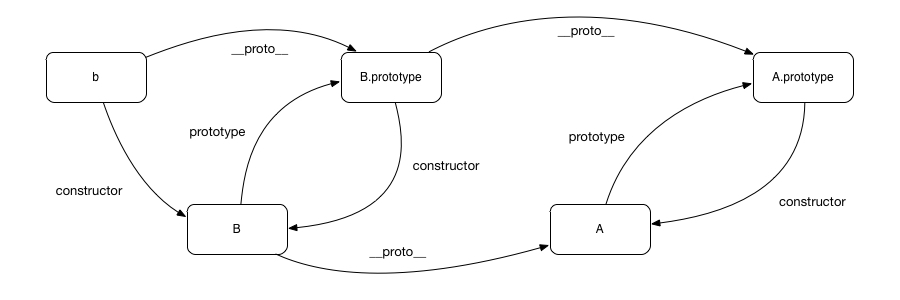我们都知道 JavaScript 是通过原型链继承的,在不支持 class、extends 语法的环境里,继承又该如何实现呢?
首先我们来整理实现继承后的效果表征,假设存在两个类(函数)A 和 B,我们要实现 B 继承于 A,那么需要满足:
- new B() instanceof A 为真;
- B.prototype.constructor === B 为真;
- 如果 A.foo = 1,则 B.foo = 1 为真,即静态变量可继承;
- 在普通方法 foo 中可以调用 super.foo() 调用基类方法;
- 在构造方法中可以调用 super() 调用基类构造方法
在很多年前,jQuery 作者 John Resig 曾写过一个继承的实现,在那个还在 ES3 语法的时代已经非常难得。在今天看来,这种实现方式的语义已经远远落后,同时也不能实现静态变量。
下面我们来一步一步地去理解 babel 的实现方式。
首先定义两个类(函数),以及子类的实例:
1
2
3
4
| function A() {}
function B() {}
var b = new B();
|
想实现 B 继承于 A,那边必然 b instanceof B 为真,根据 instanceof 的意义,一定有:
1
| b.__proto__.__proto__... === A.prototype
|
我们知道:
1
| b.__proto__ === B.prototype
|
那么我们只需要:
1
| B.prototype.__proto__... === A.prototype
|
于是我们覆写 B.prototype:
1
| B.prototype = Object.create(A.prototype)
|
这样一定有 A.prototype.isPrototypeOf(B.prototype) 为真。
现在我们已经实现了:
也就是说第一条我们已经实现了,下面看第二条,只需要:
1
| B.prototype.constructor = B;
|
或者更优雅一些:
1
2
3
4
5
6
7
8
| B.prototype = Object.create(A.prototype, {
constructor: {
value: B,
enumerable: false,
writable: true,
configurable: true
}
});
|
现在我们要实现静态成员的继承:
1
| Object.setPrototypeOf(B, A);
|
目前为止,我们定义的是两个空类,现在我们为他们增加 name 属性:
1
2
3
4
5
6
7
8
9
10
11
12
13
14
15
16
17
18
19
20
21
22
23
24
25
26
27
28
29
30
31
32
33
34
35
36
37
38
39
| function A() {}
function B() {}
A.prototype = Object.create(null, {
constructor: {
value: A,
enumerable: false,
writable: true,
configurable: true
},
name: {
get: function() {
return 'A';
},
enumerable: true,
configurable: true
}
});
B.prototype = Object.create(A.prototype, {
constructor: {
value: B,
enumerable: false,
writable: true,
configurable: true
},
name: {
get: function() {
return 'B';
},
enumerable: true,
configurable: true
}
});
Object.setPrototypeOf(B, A);
console.log(new A().name);
console.log(new B().name);
|
现在我们要在 B 的 name 中获取父类的 name 属性,那么我们就需要找到 B.prototype 中的 name。
在 B 环境中,灵活的做法是通过 B.prototype 找到 A.prototype,根据 *B.prototype = Object.create(A.prototype)*,我们知道:
1
| A.prototype === Object.getPrototypeOf(B.prototype)
|
于是:
1
2
3
4
5
6
7
8
9
10
11
12
13
14
15
16
17
18
19
20
21
22
23
24
25
26
27
28
29
30
31
32
33
34
35
36
37
38
39
40
41
| function A() {}
function B() {}
A.prototype = Object.create(null, {
constructor: {
value: A,
enumerable: false,
writable: true,
configurable: true
},
name: {
get: function() {
return 'A';
},
enumerable: true,
configurable: true
}
});
B.prototype = Object.create(A.prototype, {
constructor: {
value: B,
enumerable: false,
writable: true,
configurable: true
},
name: {
get: function() {
var sup = Object.getPrototypeOf(B.prototype);
var desc = Object.getOwnPropertyDescriptor(sup, 'name');
return desc.get.call(this) + 'B';
},
enumerable: true,
configurable: true
}
});
Object.setPrototypeOf(B, A);
console.log(new A().name);
console.log(new B().name);
|
这就实现了 super.name 的效果。当然,我们假设 B 的父类是定义了 name 的,如果没有找到 name,那应该沿着原型链继续向上寻找。因此更健壮的写法是:
1
2
3
4
5
6
7
8
9
10
11
12
13
14
15
16
17
18
19
20
21
22
23
24
25
26
27
28
29
30
31
32
33
34
35
36
37
38
39
40
41
42
43
44
45
46
47
48
| function A() {}
function B() {}
A.prototype = Object.create(null, {
constructor: {
value: A,
enumerable: false,
writable: true,
configurable: true
},
name: {
get: function() {
return 'A';
},
enumerable: true,
configurable: true
}
});
B.prototype = Object.create(A.prototype, {
constructor: {
value: B,
enumerable: false,
writable: true,
configurable: true
},
name: {
get: function() {
var sup = B.prototype, desc;
do {
sup = Object.getPrototypeOf(sup);
if (!sup) {
break;
}
desc = Object.getOwnPropertyDescriptor(sup, 'name');
} while(!desc);
return (desc ? desc.get.call(this) : undefined) + 'B';
},
enumerable: true,
configurable: true
}
});
Object.setPrototypeOf(B, A);
console.log(new A().name);
console.log(new B().name);
|
这里没有考虑 name 不是 getter 的情形,不过原理类似,不再冗述。
最后我们来实现在构造方法中调用 super()。显然,实质是在 B 函数中找到函数 A,根据 *Object.setPrototypeOf(B, A)*,我们有:
1
2
3
| function B() {
Object.getPrototypeOf(B).call(this)
}
|
我们为 A 添加一个 age 构造参数:
1
2
3
4
5
6
7
8
9
10
11
12
13
14
15
16
17
18
19
20
21
22
23
24
25
26
27
28
29
30
31
32
33
34
35
36
37
38
39
40
41
42
43
44
45
46
47
48
49
50
51
| function A(age) {
this.age = age;
}
function B(age) {
Object.getPrototypeOf(B).call(this, age);
}
A.prototype = Object.create(null, {
constructor: {
value: A,
enumerable: false,
writable: true,
configurable: true
},
name: {
get: function() {
return 'A';
},
enumerable: true,
configurable: true
}
});
B.prototype = Object.create(A.prototype, {
constructor: {
value: B,
enumerable: false,
writable: true,
configurable: true
},
name: {
get: function() {
var sup = B.prototype, desc;
do {
sup = Object.getPrototypeOf(sup);
if (!sup) {
break;
}
desc = Object.getOwnPropertyDescriptor(sup, 'name');
} while(!desc);
return (desc ? desc.get.call(this) : undefined) + 'B';
},
enumerable: true,
configurable: true
}
});
Object.setPrototypeOf(B, A);
console.log(new B(18).age);
|
于是,一个基本的继承的手写版本就实现了,当然,babel 还考虑了更多细节,比如构造方法有返回值的情况等等,但基本的继承原理就是这个样子。
下图很好地反应了诸多对象的关系。值得一提的是, b 也可能成为下一级类的 prototype,你可以清晰地看到通过 __proto__ 搜索原型链的轨迹。

在现代浏览器的不断迭代下,已经有大部分版本都实现了对 class 关键字和继承的原生支持,相信在不久的将来,就无需在这么麻烦地实现继承了。无论如何,JavaScript 继承的原理仍然是不变的,上面这些内容有助于理解原型链是怎么样工作的。
